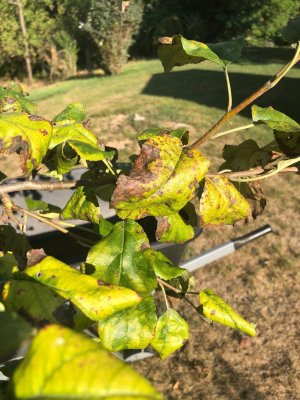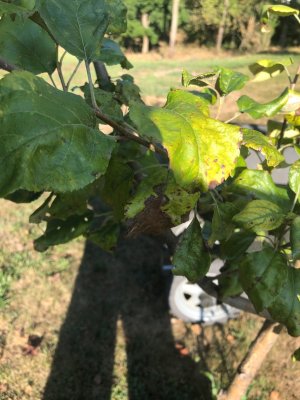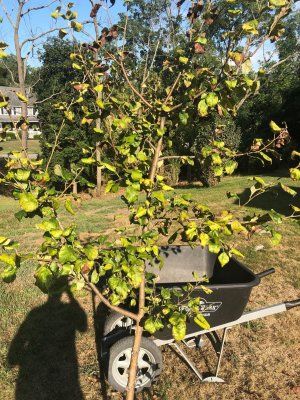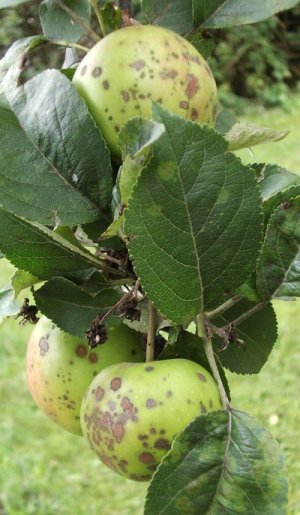The History of Honeycrisp (CONTINUED)
Additionally, the University had released three varieties in a row that disappointed growers. But it probably wasn’t the University’s fault. The three were ‘Regent’ in 1964, ‘Red Baron’ in 1970, and ‘Honeygold’, also in 1970. They were all worthy introductions that had undergone extensive evaluations and filled important spots in the lineup of apples that could be grown in this area. Regent, though the parentage wouldn’t suggest any family ties, is what most people would say a Haralson would be if it weren’t tart. Haralson and Regent were a great one-two punch, covering most taste preferences and looking very similar to each other, and Regent rose to become Minnesota’s third ranking in trees planted. Red Baron is extremely productive. It bears a lot of nice fruit. And Honeygold gave us an even sweeter answer to Golden Delicious, a very popular variety that couldn’t be grown with consistency anywhere in Minnesota. So they had done their job very well.
But Regent and Honeygold sustained significant damage in the winters of 1976-77, 1977-78, and 1983-84. Not something you’d expect from varieties developed and tested by the University of Minnesota. And Red Baron didn’t seem to turn red for anybody after it was introduced. It had colored well while being evaluated, but not after. It’s not that fun to try to sell something called “red” that’s really orange and yellow.
Growers were disgruntled. It was the talk of the winter and summer meetings.
To be fair, though, those three winters were among the worst of the century. Damage hadn’t been sustained during the “normal” Minnesota winters throughout the evaluation years. And those two varieties haven’t been hurt for over twenty years since ’83-84. And maybe Red Baron benefited from some good coloring years that haven’t come around again. Who knows? But that didn’t take the sting out of the negative experience growers were having.
So you have to figure that the University would redouble its efforts to identify problems, especially with respect to winter hardiness, before releasing another variety. (That’s the first time I’ve ever used the word “redouble.” It was fun. You should try it. It means “intensify” or “magnify.”) And that’s a hard thing to test for, if you don’t have some real harsh winters to do the work for you.
After 1978, having had two of the worst winters back-to-back, there was a gap of thirteen years before Honeycrisp was released. That’s the longest gap between University of Minnesota apple introductions since the one after Haralson’s introduction in 1922, when it took until 1936 to release Beacon.
This thing about testing and releasing, as we see, is not an overnight thing. And, oh, I almost forgot (seriously, I almost did!): Things change in thirty years. It’s easy to look back and say they could have released Honeycrisp earlier, but, as important as the weather climate, what about the apple industry climate and the consumer market climate? The two decades from 1960 to 1980, plus and minus, were dominated by the Red Delicious and Golden Delicious syndrome. These varieties and their voluminous production in Washington state trained consumers to think that apples were to be 100% red or 100% yellow. It was into the ’80s before progressive Washington grower Grady Auvil’s 1972 inspiration to break into the American market with New Zealand’s green Granny Smith apple became a significant factor. But that just added another color. Still 100% green. There wasn’t any room for stripes and partially-colored fruit until consumers found out what they had been missing when the flavorful Gala and Fuji appeared. These are very recent phenomena in the U.S. apple market. They are the third and fourth most produced apples in America now, rising rapidly while number one (Red Delicious) and number two (Golden Delicious) are falling rapidly. But until the year 2001, Gala was still so insignificant that the U.S.D.A. apple report didn’t even give it a position. It was just lumped in with “All Others.”
So, during its time of evaluation, Honeycrisp, being a beautiful but partially-colored apple, effectively waited in the wings until the big stage was set. I’m not saying the University would not have introduced Honeycrisp against the tide of Red and Golden. I don’t know that. It just takes years to get to the point of taking the leap, and maybe 1991 would have been the leaping point regardless of the current. But there’s no doubt Honeycrisp jumped into a very favorable current, one that had been started with Granny Smith and had gained irreversible momentum with Gala and Fuji. Its time had come.
But even when your time has come, if you’re an apple, it’ll still be a while. There are millions of Honeycrisp trees in the ground right now, but a production ranking is nowhere in sight. Like Gala, Honeycrisp will take a few more years before it climbs out of the “All Others” category.
So, if you’re David Bedford, and you evaluated a variety for many years until 1991 and then released it, and it’s been out now for well over a decade and it’s still in “All Others,” you’ve done a wonderful job. That’s just the speed of this game. Honeycrisp is on a meteoric rise. This is a thing that’s happening very fast, in apple terms.
I’d like to comment on what I’ve written here. There’s no one on the face of the planet who would have written this report quite the way I have. It is uniquely my viewpoint. I think it’s accurate. I like to be associated with accurate information. If anyone has a correction to make, please let me know at [
mnharvest@frontier.com]. I’m proud of the work that’s been done at the University of Minnesota. They’ve introduced numerous apple varieties that I love. I love to grow them and to sell them and to eat them and to see people enjoy them. I think they’re world class, especially from the standpoint of excellent flavor and eating quality. I do talk to Dave Bedford once or twice a year, but I didn’t consult him in the writing of this. I think that’s important for you to know. I wouldn’t want you to think I’ve been encouraged, authorized, or led to write anything either positive or negative here. It’s just how I see it. And taste it.
December 29, 2004
Surprising ‘Honeycrisp’ Information Released
Today in an interview with Topper Sponsel of Minnesota Harvest Apple Orchard, the first public release of unexpected information regarding the origins of the highly popular Honeycrisp apple was made by David Bedford, head of the apple breeding program at the University of Minnesota’s Agricultural Experiment Station. It answers one question that wasn’t even being asked, and leaves another that was thought to be known but, as it appears now, may never be known.
Records and public releases from the University of Minnesota from 1991 to the present have identified the parentage of Honeycrisp as the cross ‘Macoun’ x ‘Honeygold’. But recently completed DNA testing has determined that neither Macoun nor Honeygold are parents of Honeycrisp. That’s the answer to the question no one was asking.
The testing determined for certain that Keepsake, another apple from the University of Minnesota’s apple breeding program that was released in 1978, is one of the parents. But, despite extensive searching, the other parent has not been identified. There is no DNA match among any of the varieties that are thought to be possible parents.
Bedford proposed one explanation for the whereabouts of the parent that doesn’t seem to exist. “It might be a numbered selection and even discarded by now.”
That statement seems to leave open the possibility that a numbered selection which still exists may be the unknown parent, but he didn’t say whether there are plans for any further attempts to determine that.
No explanation was given as to how the erroneous parentage designations were made in the first place. The University’s Research Center routinely crosses and plants thousands of seeds annually, moving them and the resulting seedling trees from place to place over a period of years, so there are multiple points where a mix-up could take place. Bedford did not mention it in regard to the error, but it is a matter of public record that he began work at the University’s experimental farm in 1979 and took over the breeding program in 1982. The cross in question was made in 1960 and handled by others preceding him.
...To Be Continued






